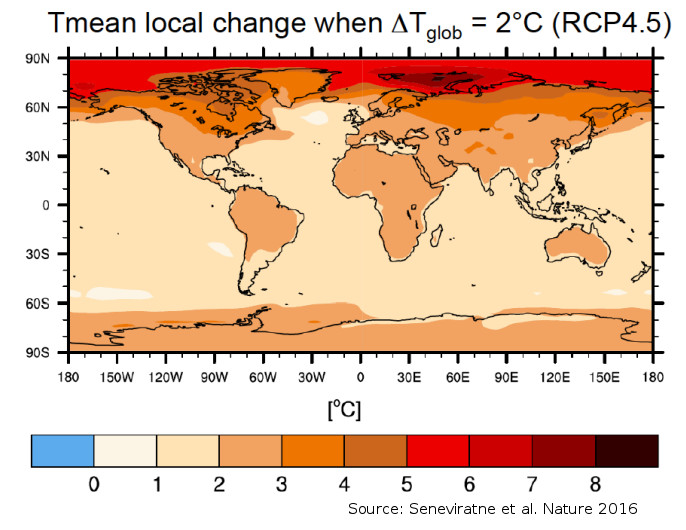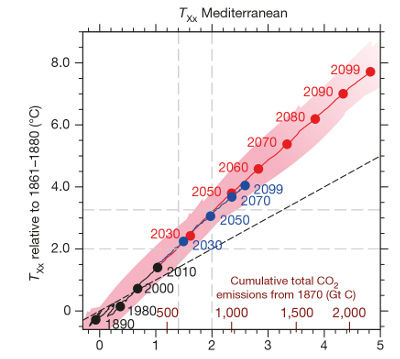Regional impact of global 2 Degrees C actually means far higher temperatures

In Paris diplomats adopted a temperature goal of "well below 2 degrees" of global warming and aspire to reach 1.5 degrees. This was a laudatory effort to bring climate policy into line with the climate science, which argues that beyond the 2 degree barrier we are likely to experience abrupt climate tipping points and enhanced climate feedbacks.
But 2 degrees Celsius average global temperature rise is a little misleading. "This climate target is abstract and invites misunderstanding,” says Sonia Seneviratne, Professor of Land-Climate Dynamics at ETH Zurich.
Seneviratne says that many people are likely to interpret two degrees globally as two degrees of warming in their region. They may then not push as hard for reducing CO2 emissions in their countries.
Seneviratne and her team at ETH Zurich in Switzerland worked with UK scientists, and Australian scientists from UNSW-based ARC Centre of Excellence for Climate System Science (ARCCSS). They calculated what an average global temperature rise of 2 degrees will mean on a regional basis from climate modelling.
Over 70 per cent of the earth's surface is ocean which spreads the average temperature, so this means for an average global temperature of 2 degrees Celsius, the average temperature over land mass and at higher latitudes will be much higher.
The scientists calculated the levels of extreme and average temperatures, as well as of heavy precipitation, that will occur in individual regions if the average global rise in temperature of 2 degrees Celsius is taken as a reference.
Graphic representations were done for each geographical region of the globe showing at a glance how average temperatures respond to the overall quantity of CO2 emitted and in relation to average global warming.
The scientists tested their new model using four examples: the Mediterranean, the USA, Brazil and the Arctic.
"We see starkly different rates of extreme warming over land even when global average temperatures reach just 1.5°C, which is the limit to the rate of warming agreed to at the Paris talks," said lead author Professor Seneviratne.
"At 1.5°C we would still see temperature extremes in the Arctic rise by 4.4°C and a 2.2°C warming of extremes around the Mediterranean basin."
For the Mediterranean example, the results reveal the following: if the global average temperature increases by 2°C, the region will see mean temperatures increase by 3.4°C on average. If, however, our aim is to limit warming in the Mediterranean to 2°C, then the global temperature must rise by no more than 1.4°C.
The highest regional temperature impact is in the Arctic where for global warming of 2°C, the average temperatures in the far north increased by 6°C. The researchers highlight that the 2°C target for the Arctic had already been exceeded when global warming reached the global average temperature increase of 0.6°C, probably around 2000.
In 2015 we appear likely to have reached 1°C of average global warming for the first time, helped by a strong El Nino.
The extreme regional warming projected for Alaska, Canada, Northern Europe, Russia and Greenland could have global impacts, accelerating the pace of sea-level rise and increasing the likelihood of methane releases prompted by the melting of ice and permafrost regions.
If emission rates don't change, areas around the Mediterranean, central Brazil and the contiguous United States could see 2°C of warming by 2030, more than a decade earlier than the widely accepted business as usual scenario, warn the scientists.
“The temperature difference between global average temperatures and regional temperature extremes over land not only has direct climate impacts, it also means we may have to reconsider the amount of carbon dioxide we can emit,” said co-author and Director of ARCCSS UNSW Professor Andy Pitman.
“For instance, to keep extreme temperature changes over the Mediterranean below a 2°C threshold, the cumulative emissions of CO2 would have to be restricted to 600 gigatonnes rather than the 850 gigatonnes currently estimated to keep global average temperatures increase below 2°C." warns Pittman.
In 2014 human generated Carbon Dioxide emissions totalled about 36 billion tonnes. "Carbon dioxide (CO2) emissions from fossil fuels and industry increased by 0.6% in 2014, with a total of 9.8±0.5 GtC (billion tonnes of carbon) (35.9 GtCO2) emitted to the atmosphere, 60% above 1990 emissions (the Kyoto Protocol reference year). Emissions are projected to decline by -0.6% in 2015 (range -1.6% to +0.5%)." explained the Global Carbon project.
The model projections also excluded unexpected changes in the climate system. It is very difficult to project when these abrupt changes may kick in. "What this research cannot take into account are abrupt climate shifts known colloquially as “tipping points”," said ARCCSS co-author UNSW's Dr Markus Donat.
"We have no way of knowing when our climate may change abruptly from one state to another meaning we could potentially see even greater regional variation than these findings show." warns Donat.
Australia
While most land-masses around the world will see an extreme temperature rise greater than 2°C, Australia appears to buck this trend. The modelled projections for Australia show little difference between global average temperatures and a change in its extreme regional temperatures.
"This might be something peculiar about Australia’s climate, or perhaps it highlights problems with the climate models," said Professor Pitman. "If the latter, there is a risk Australia will lack warnings about the increases in extremes that are now clearly available to Northern Hemisphere countries."
Most climate modelling has focussed on and been refined for the northern hemisphere. Pittman identified that this may be a potential hole in understanding of climate extremes in the southern hemisphere and needs urgent resolution with more focused model development.
Sources:
- Alvin Stone, University of NSW Newsroom, 22 January 2016, How a 2°C rise means even higher temperatures where we live
- Peter Rüegg, ETH Zurich University, 21 January 2016, How two degrees may turn into four
- Seneviratne SI, Donat MG, Pitman AJ, Knutti R, Wilby RL. Allowable CO2 emissions based on regional and impact-related climate targets. Nature, Advanced Online Publication, 20th January 2016. DOI: 10.1038/nature16542 (Abstract)
- Global Carbon Project - Global Carbon Budget
Get Involved
If you'd like to help with maintaining or developing the website, contact us.
Publish
Publish your stories and upcoming events on Indybay.



